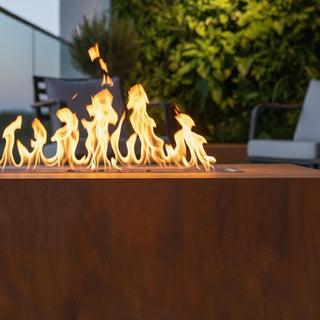A fire feature adds beauty and warmth to any outdoor setting, but safety must always come first. Whether your fire pit runs on wood, gas, or another fuel source, following proper guidelines ensures years of safe and enjoyable use.
Placement and Clearances
Choose the Right Location
Position your fire pit on a stable, level surface, away from structures, trees, fences, and other flammable materials. Maintain a minimum of three inches of clearance between the burner and the interior walls of the enclosure.
Provide Ventilation
Adequate airflow prevents overheating and supports clean combustion. Never install a fire pit in a fully enclosed space unless it is specifically rated for that use.
Follow Manufacturer Guidelines
Always refer to the installation and operation manual for safe clearances, ventilation requirements, and local code compliance.
Supervision and Awareness
Stay Attentive
Never leave a fire pit unattended. Extinguish the flames completely when finished using it.
Protect Children and Pets
Keep kids and pets at a safe distance, and establish clear boundaries around the fire feature.
Be Aware of Wind Conditions
Avoid using your fire pit during strong winds. Gusts can cause uneven flames or carry embers beyond the burn area.
Safe Operation
Use Approved Fuel Only
Operate your fire pit only with the fuel it was designed for, such as natural gas, propane, or seasoned firewood.
Follow Safe Ignition Practices
Light your fire pit according to the manufacturer’s instructions. For gas systems, ensure all valves and ignitions are functioning properly before use.
Avoid Accelerants
Never use lighter fluid, gasoline, or other flammable liquids to start or boost a fire.
Fully Extinguish Flames
Use water, sand, or a fire extinguisher to ensure all embers and flames are out before leaving the area.
Essential Safety Equipment
Keep these items within reach whenever your fire pit is in use:
-
A fire extinguisher rated for the appropriate fuel type
-
A water source or bucket of sand for emergencies
-
A first aid kit
-
A spark screen or wind guard to contain embers and protect nearby surfaces
Regular Maintenance
Inspect Frequently
Check for rust, corrosion, cracks, and loose fittings. Clean the burner ports and air vents to ensure proper airflow.
Maintain Components
Confirm that gas lines, valves, and ignition systems are secure and in good condition.
Schedule Professional Inspections
Have a certified technician inspect your fire pit periodically to verify safety and compliance with local regulations.
By following these essential practices, you can enjoy the beauty of fire with confidence and peace of mind. At Modofire, we design every fire feature with safety, performance, and craftsmanship in mind — helping you create spaces that are as secure as they are inspiring.


